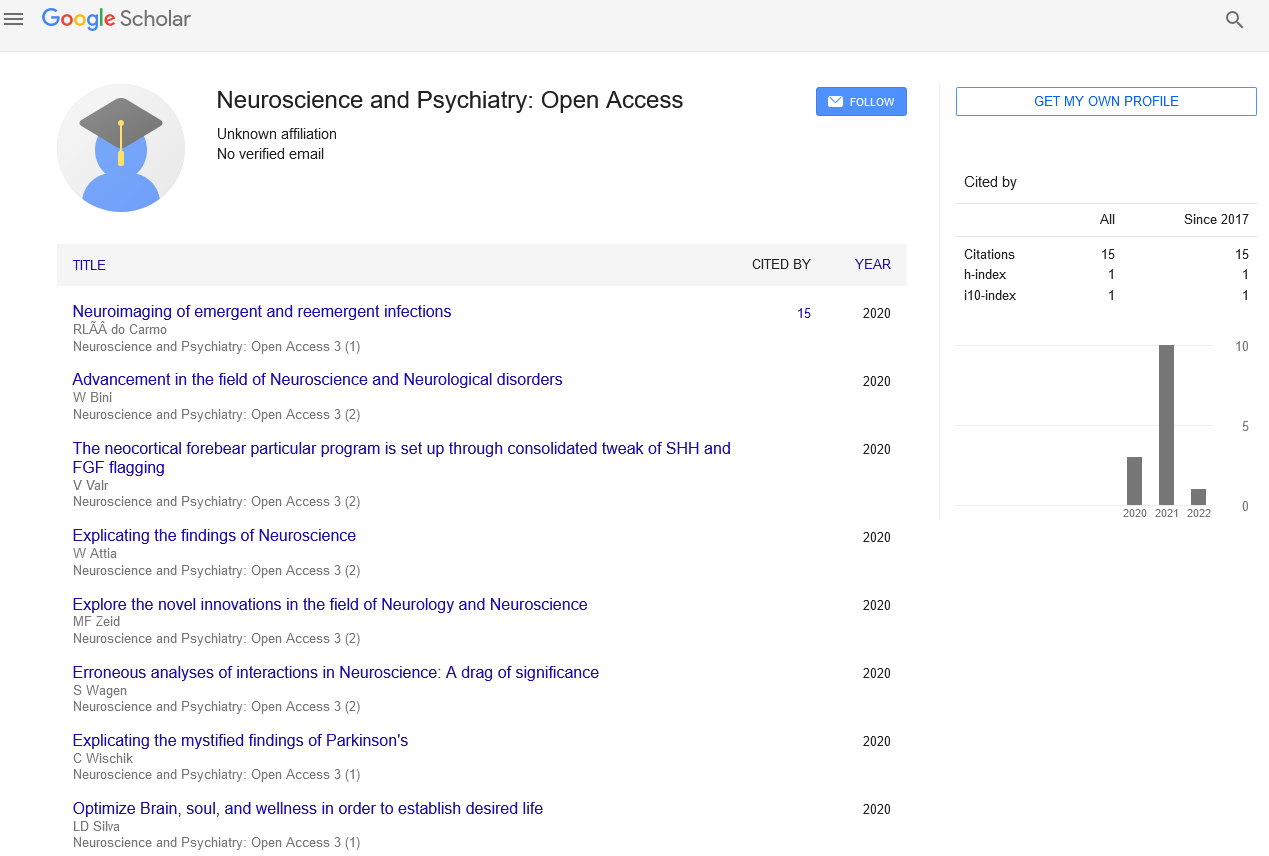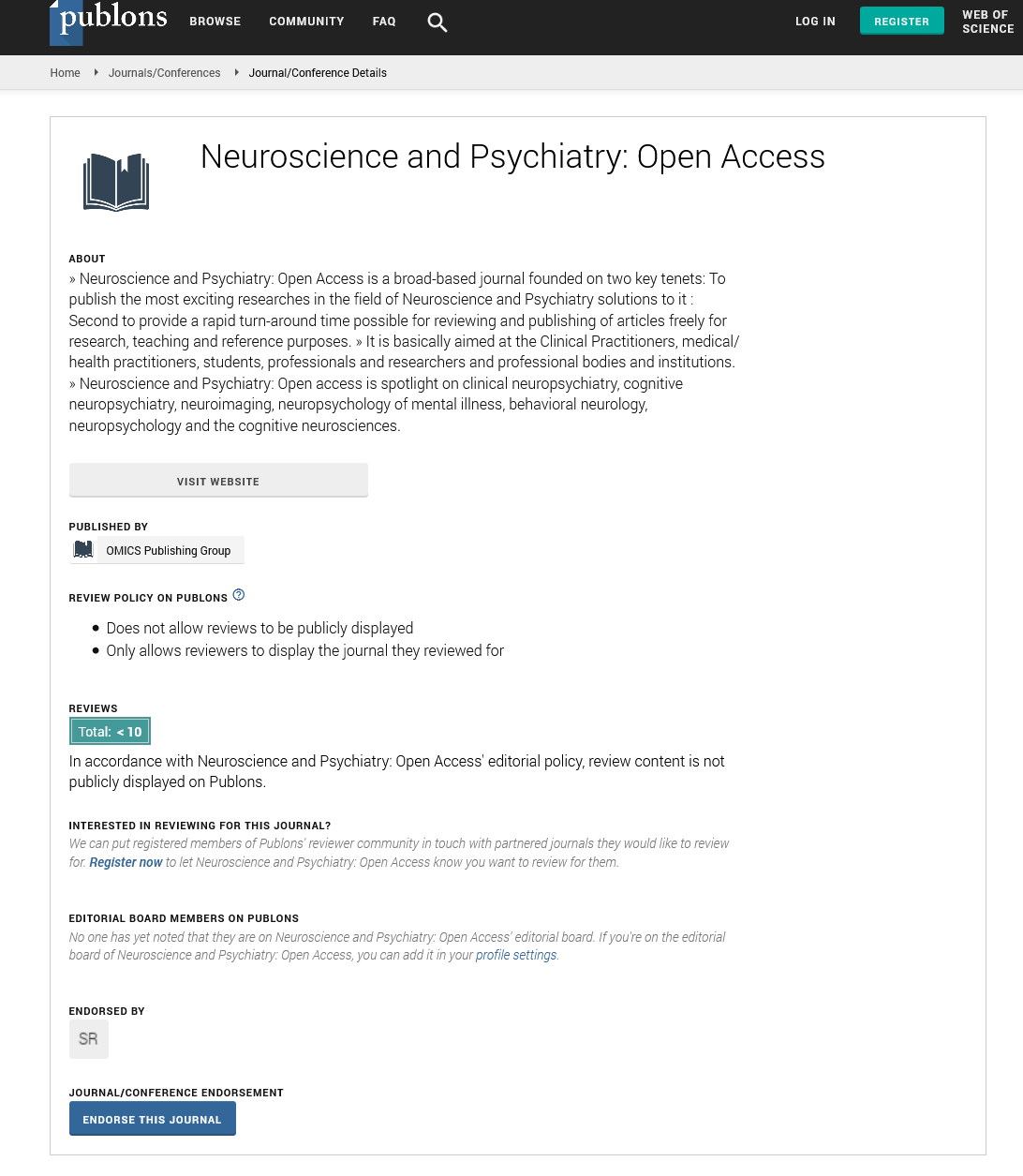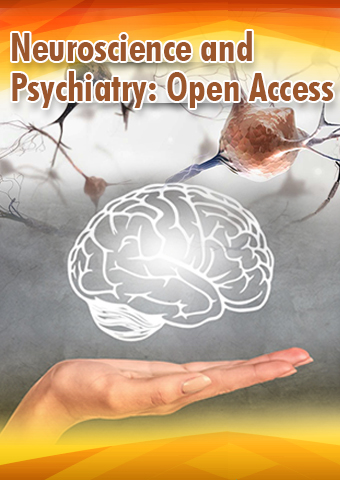Perspective - Neuroscience and Psychiatry: Open Access (2024) Volume 7, Issue 2
Unraveling Schizophrenia: Understanding the Complexities of a Multifaceted Disorder
- Corresponding Author:
- Marina Adami
Department of Brain and Behavioral Sciences, University of Pavia, Pavia, Italy
E-mail: Madami42@its.jnj.com
Received: 16-02-2024, Manuscript No. NPOA-24-128843; Editor assigned: 19-02-2024, PreQC No. NPOA-24-128843 (PQ); Reviewed: 04-03-2024, QC No. NPOA-24-128843; Revised: 14-03-2024, Manuscript No. NPOA-24-128843 (R); Published: 21-03-2024, DOI: 10.47532/npoa.2024.7(2).191-193
Introduction
Schizophrenia is a complex and debilitating psychiatric disorder that profoundly affects the lives of millions worldwide. Characterized by disturbances in thought, perception, emotion, and behaviour, schizophrenia poses significant challenges for individuals, families, and society as a whole. Despite decades of research, the underlying causes and mechanisms of schizophrenia remain elusive, hindering the development of effective treatments and interventions. In this article, we delve into the multifaceted nature of schizophrenia, exploring its clinical features, neurobiological underpinnings, and the quest for innovative approaches to diagnosis and treatment.
Description
Clinical features of schizophrenia
Schizophrenia manifests as a constellation of symptoms that can vary widely in severity and presentation among affected individuals. The diagnostic criteria outlined in the Diagnostic and Statistical Manual of mental disorders (DSM-5) include:
• Positive symptoms: Positive symptoms are disturbances that reflect an excess or distortion of normal functioning and include hallucinations, delusions, disorganized thinking (manifested as disorganized speech), and grossly disorganized or catatonic behaviour. Hallucinations, typically auditory in nature, involve perceiving sounds or voices that are not based in reality. Delusions are fixed false beliefs that are resistant to reasoning or contradictory evidence.
• Negative symptoms: Negative symptoms represent deficits or impairments in normal functioning and include diminished emotional expression, avolition (lack of motivation or initiative), anhedonia (inability to experience pleasure), and social withdrawal. Negative symptoms can have a profound impact on an individual’s ability to engage in daily activities, form relationships, and maintain employment.
• Cognitive symptoms: Cognitive symptoms encompass impairments in various cognitive domains, including attention, memory, executive function, and social cognition. Individuals with schizophrenia may experience difficulties in maintaining attention, processing information, and making decisions. Impairments in social cognition, such as recognizing and interpreting social cues, can contribute to social dysfunction and interpersonal difficulties.
• Affective symptoms: Affective symptoms refer to disturbances in mood and affect and may include depression, anxiety, and dysphoria. While affective symptoms are not specific to schizophrenia, they frequently co-occur with other symptom domains and can significantly impact overall functioning and quality of life.
Neurobiological underpinnings of schizophrenia
The pathophysiology of schizophrenia is thought to involve complex interactions between genetic, neurodevelopmental, and environmental factors, leading to alterations in brain structure and function. While the precise mechanisms remain incompletely understood, several neurobiological abnormalities have been implicated in the etiology of schizophrenia:
• Dopaminergic dysregulation: Dysregulation of dopamine neurotransmission is a central feature of schizophrenia pathology. The dopamine hypothesis posits that hyperactivity of dopaminergic pathways, particularly in the mesolimbic and mesocortical pathways, contributes to positive symptoms such as hallucinations and delusions. Conversely, hypoactivity of dopaminergic pathways in the prefrontal cortex is thought to underlie negative symptoms and cognitive impairments.
• Glutamatergic dysfunction: Alterations in glutamatergic neurotransmission, particularly involving the N-methyl-D-aspartate (NMDA) receptor, have been implicated in the pathophysiology of schizophrenia. Hypofunction of NMDA receptors may disrupt synaptic plasticity, impair neural circuitry, and contribute to cognitive deficits and negative symptoms. Dysfunction of other glutamate receptors, such as α-amino-3-hydroxy-5-methyl-4-isoxazolepropionic acid (AMPA) receptors, may also play a role in schizophrenia pathology.
• Neurodevelopmental abnormalities: Schizophrenia is increasingly recognized as a neurodevelopmental disorder, with disruptions in brain development occurring early in life. Prenatal and perinatal factors, such as maternal infection, obstetric complications, and maternal stress, have been associated with an increased risk of schizophrenia. Neuroimaging studies have revealed structural abnormalities, including alterations in brain volume, cortical thickness, and white matter integrity, suggesting aberrant neurodevelopmental processes in schizophrenia.
• Genetic factors: Genetic factors play a significant role in the etiology of schizophrenia, with heritability estimates ranging from 60% to 80%. Genome Wide Association Studies (GWAS) have identified numerous genetic variants associated with schizophrenia risk, implicating genes involved in neurotransmission, synaptic function, and neurodevelopment. While individual genetic variants confer only modest increases in risk, their cumulative effects contribute to the polygenic nature of schizophrenia susceptibility.
Innovations in diagnosis and treatment
Advances in diagnostic methods, including neuroimaging, genetic testing, and biomarker discovery, hold promise for improving early detection and personalized treatment of schizophrenia. Key innovations include:
• Neuroimaging biomarkers: Structural and functional neuroimaging techniques, such as Magnetic Resonance Imaging (MRI), Positron Emission Tomography (PET), and functional MRI (fMRI), provide valuable insights into brain abnormalities associated with schizophrenia. Neuroimaging biomarkers can aid in the early detection of schizophrenia, predict treatment response, and monitor disease progression. For example, alterations in brain connectivity and functional networks may serve as biomarkers for cognitive impairment in schizophrenia, guiding the development of targeted interventions.
• Genetic testing: Advances in genomic technologies, including GWAS and Next Generation Sequencing (NGS), have led to the identification of genetic variants associated with schizophrenia risk. Genetic testing may help identify individuals at increased risk of developing schizophrenia, inform treatment decisions, and facilitate personalized interventions. Pharmacogenomic testing, which assesses an individual’s genetic profile to predict medication response and adverse drug reactions, holds promise for optimizing pharmacotherapy in schizophrenia.
• Biomarker discovery: Biomarkers derived from blood, Cerebrospinal Fluid (CSF), or other biological samples may provide valuable insights into the pathophysiology of schizophrenia and facilitate diagnosis and treatment monitoring. Potential biomarkers include inflammatory markers, oxidative stress markers, neurotrophic factors, and micro RNA profiles. Biomarker based diagnostic tests and treatment response assays may enhance the precision and efficacy of interventions for schizophrenia, improving outcomes for affected individuals.
• Targeted therapies: While antipsychotic medications remain the cornerstone of treatment for schizophrenia, there is growing recognition of the need for targeted therapies that address specific symptom domains and underlying pathophysiological mechanisms. Novel pharmacological agents targeting glutamatergic neurotransmission, dopaminergic signaling, and other molecular pathways are under investigation for the treatment of schizophrenia. Additionally, non-pharmacological interventions, such as cognitive-behavioral therapy, social skills training, and supported employment programs, complement pharmacotherapy and address functional impairments in schizophrenia.
Conclusion
Schizophrenia represents a complex and multifaceted disorder with profound implications for affected individuals, families, and society. Despite significant advances in our understanding of its neurobiological underpinnings, schizophrenia remains a challenging condition to diagnose and treat effectively. Innovations in diagnostic methods, biomarker discovery, and personalized interventions offer promise for improving early detection, optimizing treatment outcomes, and enhancing the quality of life for individuals living with schizophrenia. By leveraging cutting edge research and interdisciplinary approaches, we continue to unravel the mysteries of schizophrenia and strive towards better treatments and ultimately a cure for this devastating disorder.


